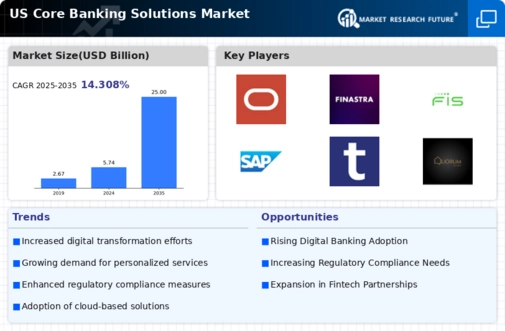The US Core Banking Solutions Market has witnessed significant evolution and competitive dynamics as financial institutions increasingly adopt digital transformation strategies to enhance operational efficiency, customer experience, and compliance with regulatory requirements. Key players in this market are focusing on innovation, technological advancements, and strategic partnerships to create robust platforms that cater to the diverse needs of banks and credit unions.
As competition intensifies, the emphasis on providing scalable, flexible, and integrated solutions has become paramount for market leaders aiming to maintain a competitive edge and capture a larger share of this lucrative sector.Oracle has established a formidable presence in the US Core Banking Solutions Market, renowned for its comprehensive suite of banking applications that enable institutions to streamline processes and optimize customer interactions. The strengths of Oracle lie in its extensive expertise in enterprise-grade technology, significant investments in cloud services, and the ability to provide tailored solutions addressing the specific needs of financial institutions.
Oracle’s solutions are characterized by high scalability and security, which makes them appealing to banks of various sizes looking to modernize their operations. Additionally, Oracle’s strong focus on innovation, along with its robust research and development capabilities, has positioned the company as a leader in driving digital transformation in the banking sector.Jack Henry & Associates has made a prominent mark in the US Core Banking Solutions Market, specializing in providing technology solutions that empower community banks and credit unions.
The company offers a range of key products and services, including core processing systems, payment solutions, and digital banking platforms designed to enhance customer engagement and operational efficiency. Jack Henry & Associates prides itself on its strong customer-centric approach, emphasizing collaborative solutions tailored to meet the unique demands of regional institutions. The company’s strengths lie in its ability to enhance client relationships through attentive service and innovative product offerings.
Further bolstered by strategic mergers and acquisitions, Jack Henry has expanded its technology capabilities and market presence, positioning itself as a trusted partner for financial institutions seeking to adapt to change and enhance their service offerings in the dynamic US banking landscape.


















Leave a Comment